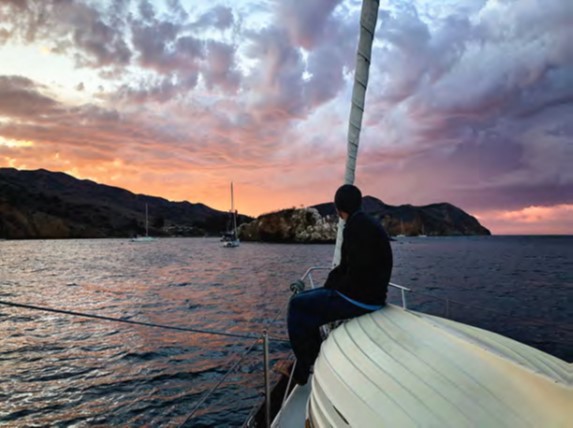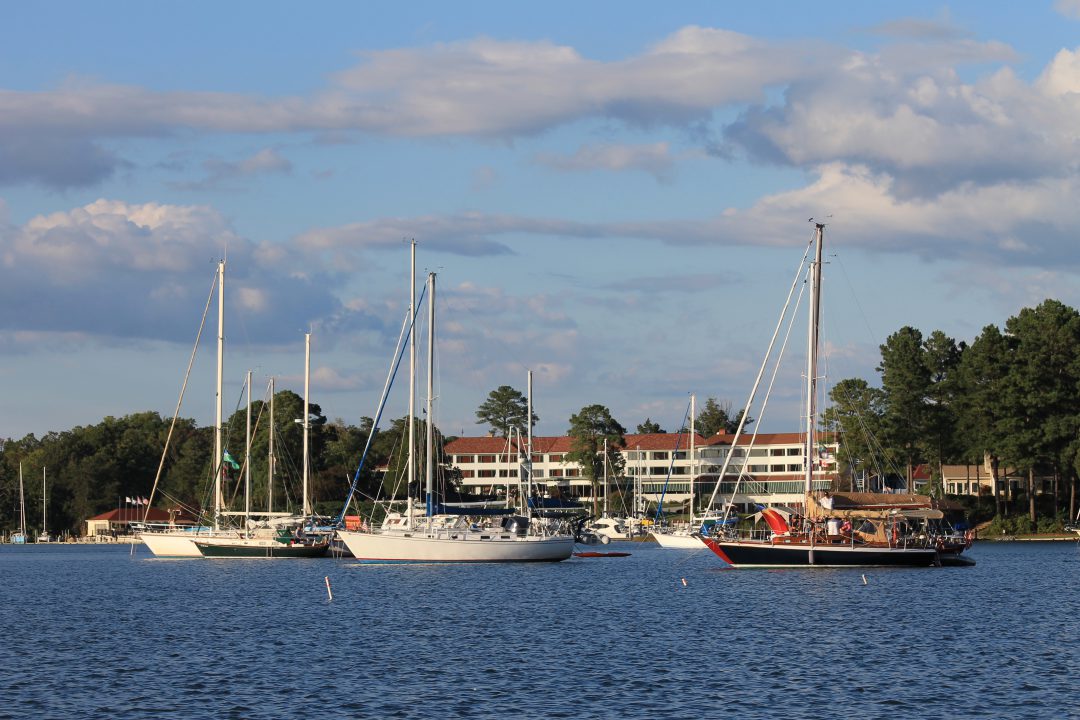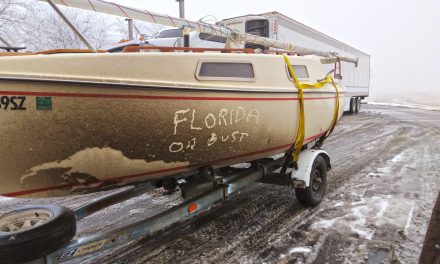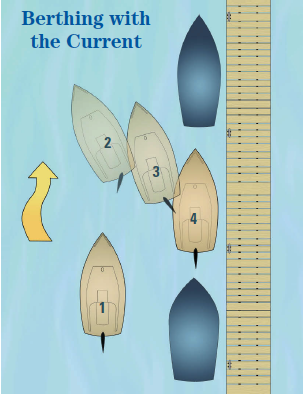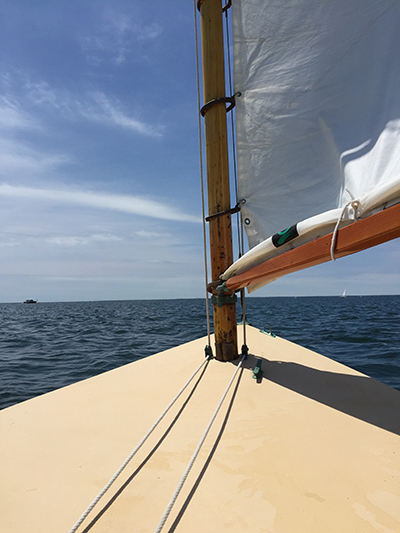An unpredicted nighttime wind shift created a dangerous situation that demanded quick action.
Issue 143: March/April 2022
After months of boat work, my partner, Chris, and I sat back to enjoy the fruits of our labor while anchored in Emerald Bay at California’s Catalina Island, tucked behind Indian Rock. Our 1979 Cheoy Lee 41, Avocet, had been home for three years, but we seemed to spend a lot more of that time working on projects than sailing, so feeling the movement beneath the keel was welcomed with every breath the ocean took, rocking us gently in the October sun.
It was the perfect belated-summer day spent snorkeling with friends, hiking along the shoreline, and enjoying the 80-degree weather. It wouldn’t last.
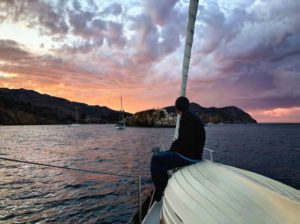
Chris sits at Avocet’s bow at sunset as the evening’s tumultuous weather approaches.
A large weather system out of the north formed above us, bringing the most magnificent colors at sunset but also a strange, rather foreboding combination of hot, salty, damp air sliced by sharp, cold wind off the water. After reviewing the weather reports and consulting local sources, we decided to let out more scope, anticipating the accurately predicted 28-knot winds of northwest wind that was expected to die down at around 2:00 a.m.
As the wind built outside to a harrowing howl, we enjoyed the warmth and comfort inside our cabin thanks to our diesel heater. The storm was balefully beautiful, with thunderclaps that rattled our bones, sheets of rain that washed our decks, and stringy fingers of lightning that touched down all around us, illuminating the sky for brief moments before everything faded to black once more.
We were safe and sound, capturing the event with our camera and tucking our electronics into the oventurned-Faraday-cage for safekeeping. The wind was blowing us safely away from the land mass, and we were at the end of our scope, about 20 yards from Indian Rock. Before turning in for the night, Chris completed his final deck check while I secured the portlights and hatches below.
Hours later, the sound of water crashing violently into rocks was our alarm—quite literally—springing us into action. Chris ran on deck, shirtless, while I scrambled to put my contact lenses in—I’m uselessly blind without them. To our horror, we saw that we were fewer than two boat lengths away from Indian Rock.
The weather system we had gone to bed with had passed as predicted, only to be replaced by an unpredicted gale-force wind from the opposite direction, putting us on a perilous lee shore.
I threw my foulie jacket on and took the helm while Chris charged to the foredeck in hopes of bringing in the additional scope that had kept us secure during the first storm. I glanced behind me at the rock we had spent the afternoon swimming around and felt my stomach flip. It was so close I could nearly touch it.
Lightning cracked over the island while Avocet’s bow lurched up and down in the 5- to 6-foot chop that slapped us every five seconds or so. It was like riding an enraged bull as white water splashed up the sides of the hull like shattered glass.
With the engine on and me at the helm, Chris used the windlass to retrieve 100 feet of the original 175 feet of chain, leaving a 2-to-1 scope. Although we were much further away from the rock, it was still way too close for comfort, and the scope was terribly insufficient for the 35 knots of southeasterly wind. We needed to move.
Our windlass tore the 55-pound Vulcan from the seabed like a champ, and after struggling for a few minutes, Chris managed to lash the anchor on the bow in
the heavy seas without taking any paint off the boat or skin off his limbs. I watched nervously from the helm as he stood there securing the anchor, shirtless, soaked repeatedly in showering spray, and not a life vest or tether to be seen.
With the anchor up, I revved the engine to gain distance from shore as Chris secured two reefs in the main and hoisted the sail within the span of five minutes. I threw his PFD at him, his adrenaline keeping him warm without a shirt. With a small amount of genoa unfurled, we broke off the wind and chop at about 35 degrees, making for deeper water.
A mile or so from the anchorage in 100-plus feet of water, I turned off the engine and let the sails keep us moving at 6.5 to 7 knots. After another 3 miles or so, we hove to, bringing the boat to a near stop, reducing the aggressive rolling and returning a small sense of comfort.
At this point, we were able to reconvene, layer up with some clothing, and figure out a plan. Simultaneously shaken and awed, Chris and I watched as lightning continued to split the sky and dark clouds rolled over the island, seeming to bleed into the ink-black sea. We decided to wait out the storm hove to in the safety of the deep water, then make a break for Avalon—a well-known harbor on the island about 20 miles away—when the winds lightened up.
I was fading from the excitement, my fingertips cold in the chilled early morning air. From below deck I grabbed two blankets and a pillow, making myself comfortable in the cockpit. I wasn’t going anywhere in case Chris needed me.
Eventually I dozed off, and we remained hove to for another two hours before the wind resumed its normal direction from the northwest. Chris shook out the reefs, raised the main, and unfurled the genoa, still wet from the rain. At dawn, the clouds dissipated, and the sun brought bluebird skies, a complete 180-degree change from the few hours before. That day, we lounged beachside in 80-degree weather, our fellow beachgoers having no idea what we had endured to get safely to that very spot.
Chris and Marissa Neely have been living aboard and upgrading their 1979 Cheoy Lee 41, Avocet, since 2018. Primarily they sail in and around Southern California’s Channel Islands. Follow them at www.svavocet.com, on other social platforms at @svavocet, and on their YouTube channel called Sailing Avocet.
Thank you to Sailrite Enterprises, Inc., for providing free access to back issues of Good Old Boat through intellectual property rights. Sailrite.com

